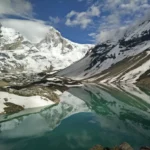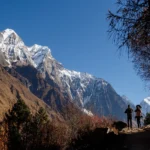Hiking vs Trekking is often used interchangeably as synonyms. The two terms are used with the same connotations. But are they similar or is there a difference between Hiking and Trekking? Turns out, the terms hold different meanings, and hiking and trekking are two separate activities.
Imagine you are embarking on a week-long journey to the mountains. The journey includes long walking hours, multi-day hikes, and sleeping in tents or tea houses, with constant altitude gain.
Now imagine you live in Pune. On Sunday morning you gather your friends prepare your day pack, and decide to climb to Sinhagad.
So did you go hiking or trekking in these two scenarios? Many people often use the terms hiking and trekking interchangeably unknowingly. Although the terms are synonymous with outdoors, nature, and mountains, they hold different meanings. Hiking and Trekking differ in terms of skills required, risks involved, time and equipment needed, and physical stamina required.
So, let’s delve further to understand the difference between hiking and trekking.
Table of Contents
- Hiking vs Trekking Definition
- What is Hiking?
- What is Trekking?
- What are the health benefits of hiking and trekking
- How to make your hiking and trekking experience safer
- Tips to start hiking
- Tips to start your trekking journey
- Conclusion
What does the definition say?
Hiking - if you look up a definition of hiking, this is what the Oxford Dictionary shows - “the activity of going for long walks in the country for pleasure.”
Trekking - “to make a long or difficult journey, especially on foot.”
If we go by the dictionary definitions, there is a slight difference between hiking and trekking. Trekking is defined as an arduous journey, while hiking is referred to as a long walk for pleasure. While both activities involve walking for long hours, hiking is typically limited to a day or two, while trekking lasts more than two days. Additionally, hiking usually follows a well-established trail, whereas trekking often involves traversing rugged terrain in challenging environments.
Hiking vs trekking – What is the difference?
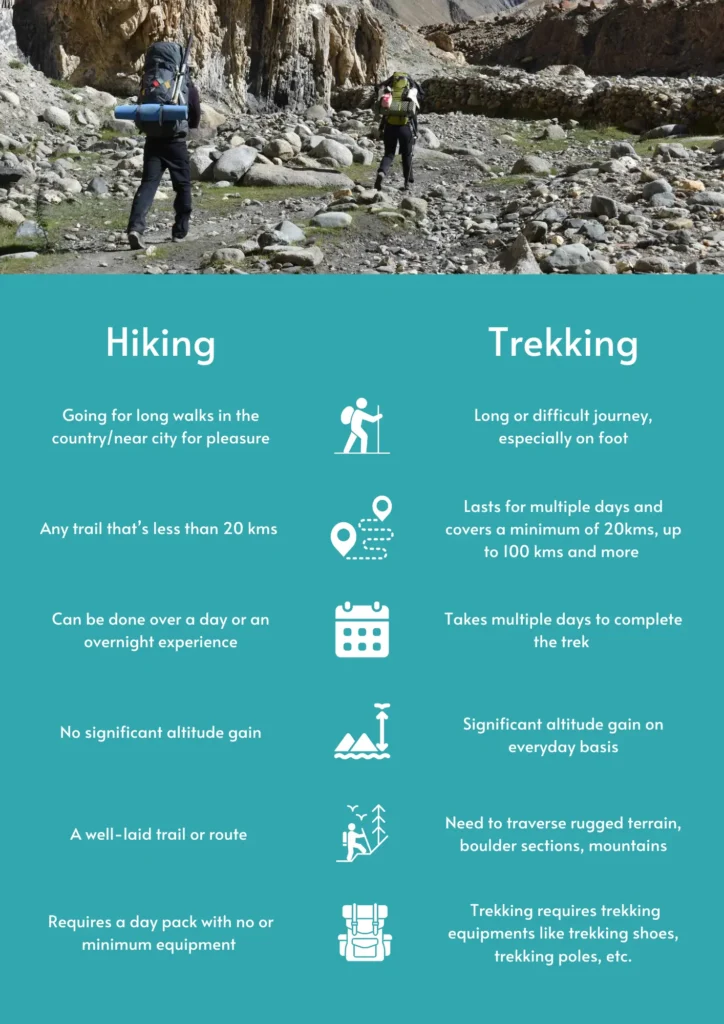
That being said, all the adventures have distinct challenges, risks, fun, and requirements. Therefore, it is important to know them well before you choose any adventure for your next trip.
Let’s learn more about these two terms individually.
What is Hiking ?
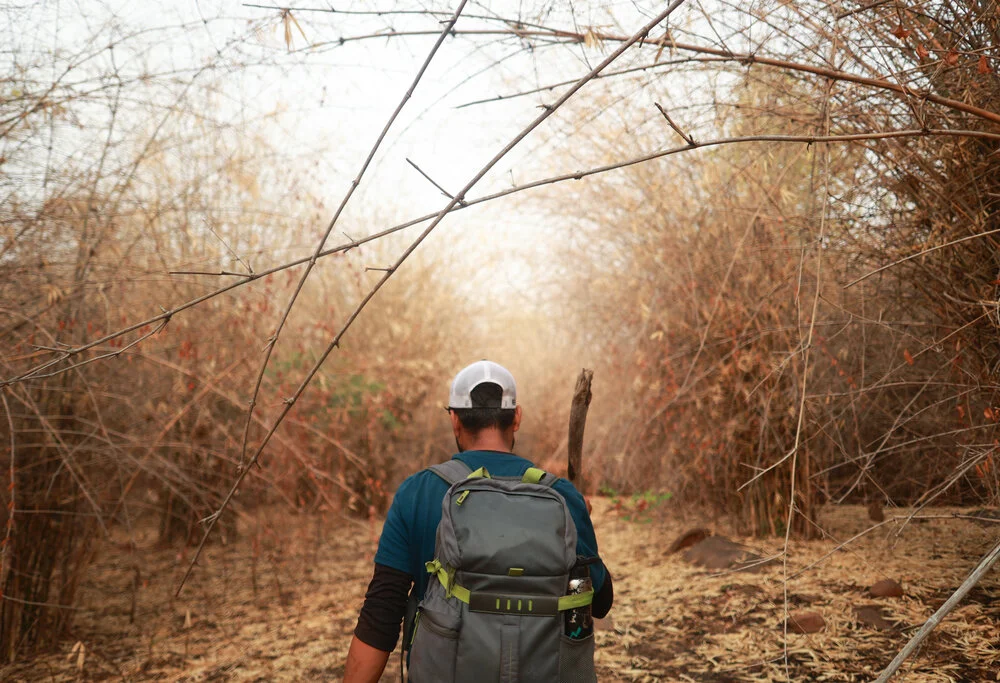
Hiking refers to long hours of walking on a well-defined trail near the city or in the neighbourhood park or forest. It is usually a one-day journey, covering a specific trail or a point on that trail. Hiking doesn’t necessarily have a particular spot or a destination. It generally depends on an individual whether to hike up to a certain distance or reach the destination in mind. You can cover a distance up to a point and make it a round trip or go to the other end of the trail. Although hiking is typically a short trip, you can extend it to a few more days according to your will and physical fitness.
Hiking is seen as an easily accessible adventure that doesn’t require much technical knowledge. While it’s an accessible adventure activity, the difficulty level and elevation gain on hiking trails vary significantly. Hence it is important to select the trail after researching. Choose a trail that suits your fitness. If hiking with children and family, choose an easy trail with minimal elevation changes.
If you are well-prepared for a hike, hiking rewards you with an unforgettable experience. You can explore and immerse in untouched wildlife, flora and fauna of the region while availing the tranquil bliss of nature that is amiss in busy city life.
What is Trekking?
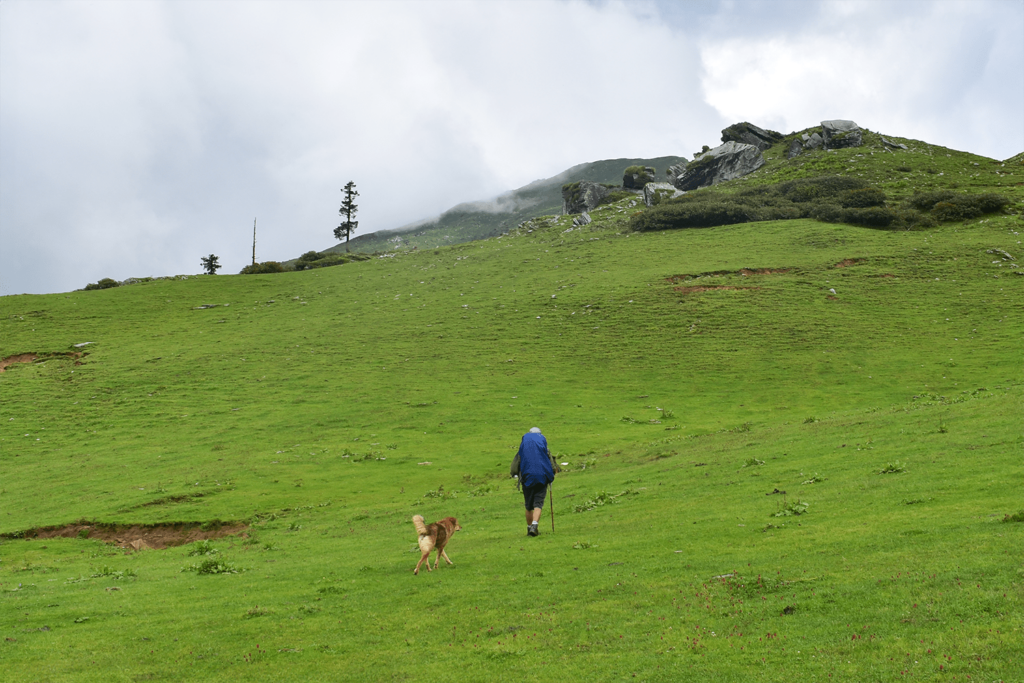
Unlike hiking, trekking typically involves walking on more demanding trails and unfamiliar terrain. Trekking, as an activity, can last for several days.
It demands more time and effort than hiking, with treks ranging from 2 to 8 days and sometimes extending to 15 days. Treks can be easy, moderate, or difficult based on terrain, distance, and altitude.
Easy treks can last for 3 to 4 days and moderate treks usually take 5 to 7 days. Difficult treks are suitable for people with prior exposure to high altitude and last for eight to ten days. They usually cover around 20 to 50 kilometres, however, some difficult treks span more than 100 kilometres and involve significant elevation gain of up to 16,000ft to 18,000ft for treks like Everest Base Camp Trek.
As you ascend the trail, the terrain changes constantly while trekking in the mountains. Unlike hiking, you require special equipment to navigate uneven mountain terrain. Some trails pass through different villages where trekkers can learn about local culture. They also provide accommodation for trekkers or you can opt to camp by the village. Treks like Sandakhphu in West Bengal and Markha Valley in Ladakh open the doors of tea houses to trekkers. These tea houses provide a glimpse of their diverse culture.
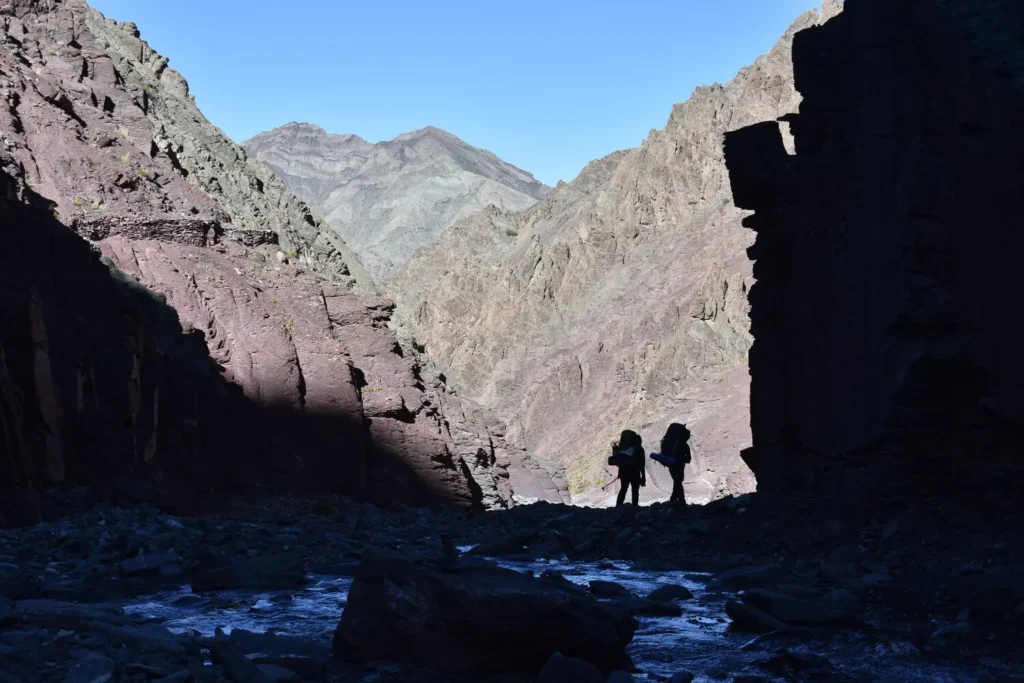
Trekking opens a gateway to a different world for those ready to tackle challenging trails. From snow-studded Himalayan peaks to forests bursting with rhododendron bloom, and lush green valleys to thrilling high-altitude passes, trekking unravels a plethora of landscapes that will mesmerize you throughout your journey.
What are the health benefits of hiking and trekking
There’s an obvious fitness element in these adventures. Hiking and Trekking involve a high level of physical activity, leaving a positive impact on your health. By engaging in both activities regularly, your cardiovascular strength can significantly increase. You spend most of the time in the mountains, amidst nature, and witness the power and positivity it instills in you. But besides various health factors, there are also many other benefits of these activities.
1. Better for fitness
Going hiking near your city over a weekend or a day off can be an ideal activity for your fitness. As hiking involves walking for long hours it helps to build endurance. As you are putting your muscles to work, you will strengthen your thigh muscles, hamstrings, and lower leg muscles.
Trekking involves rigorous walking on a mountain terrain. This helps to boost your endurance, as you are constantly moving your body with a load of trekking backpacks. Traversing an undulated terrain in a remote mountain region boosts your core strength, thereby improving your fitness.
2. Positive impact on your mental health
Spending time in the wilderness has proven health benefits. There have been many studies on the role of nature in reducing anxiety and depression.
Exposing ourselves to diverse colors of nature impacts us positively. Exploring new paths in the wilderness helps you to discover new perspectives in life reducing stress and anxiety.
3. Helps you to burn calories
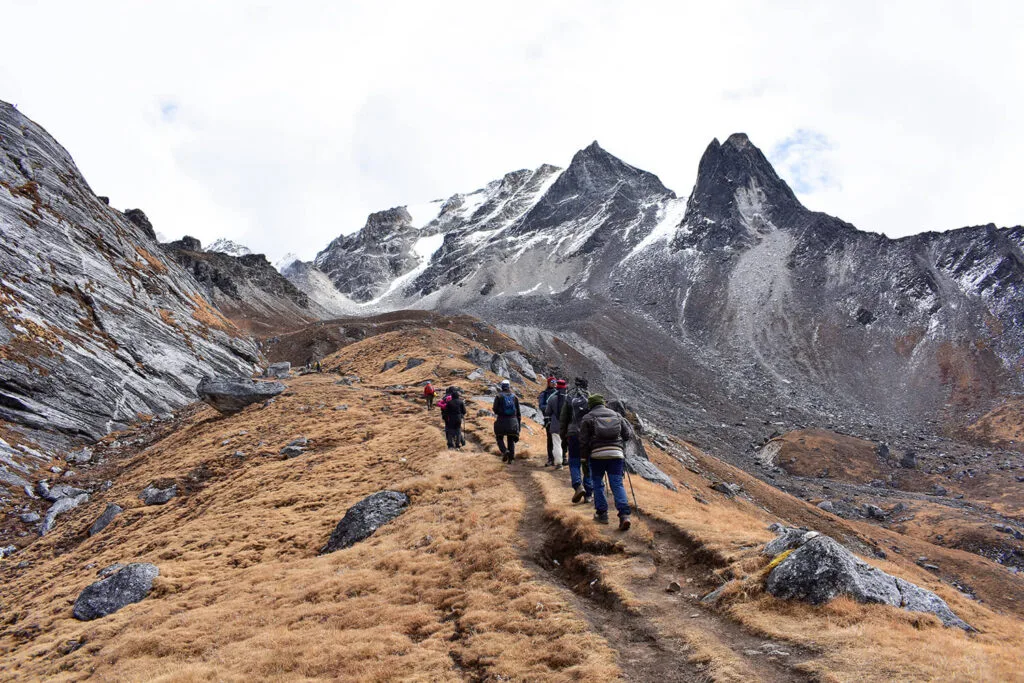
Hiking and trekking are activities that put your entire body to work. While traversing undulated and rugged terrain, you will exercise different muscle groups, burning significant calories. On any trek, you will walk for at least 4 to 5 hours daily. This helps to burn off what you consume during the journey.
Many trekkers return to the base and complain that their trek pants have become loose.
4. Boosts your creativity
Whether you are hiking or trekking, you are away from distractions. Imagine serene surroundings, clear blue skies, the sound of nature and blooming wildflowers, towering mountains, lush green trails and no networks on your mobile phone. Being close to the tranquillity of nature improves your focus, helping you to discover newer perspectives. This aids you in finding enhanced creative streaks.
5. Improves sleep quality
If you have a hard time sleeping, perhaps you should try hiking.
Vitamin D deficiency is associated with sleep disorders and poor sleep quality. Going on hikes and treks exposes you to a constant supply of Vitamin D. It is believed that Vitamin D plays a crucial role in sleep-wake cycles. As trekking outdoors exposes you to direct sunlight, you will return home to better and improved sleep cycles.
How to make your hiking and trekking experience safer
- Search and select the right trail to hike/climb/trek. The selection of the trail should be based on the season, duration, budget, terrain, and your companions. If you are a group of beginners on a hike, select an easy hike that takes a day to complete.
- Make a detailed plan. Engaging in detailed research is key to a successful hike. Look for a trail map, places to eat, water resources, trail distance, and emergency numbers before hiking near your city.
- Inform family/ friends about your plans including the duration of your journey and no network zones, etc.
- Pack your backpack with essentials. Remember to include the essentials like a medical kit, equipment, extra warm clothes, sunscreen, trail snacks and, more importantly, water.
- Try to stick to the plan as much as possible. Do not take any digression to explore. This can lead to wandering off on the trail. Start early and avoid trekking in the night.
- Keep a safe distance from the wild animals, especially when carrying food. If the hiking trail is known for wild animals presence, take a necessary precaution. Communicate with villagers at the base, or forest guards before proceeding.
- Hire a Guide. Many hiking trails are located inside reserve forests and national parks, requiring you to hire a guide. Do not hesitate to spend a few bucks and hike with a guide to avoid getting lost in the vast forest areas.
Tips to start hiking
Hiking is a perfect way to spend time close to nature and embrace the serenity around it. The activity is not demanding. You can explore hikes near the city over the weekend. You can start your journey with short day hikes around your city, and slowly progress to weekend hikes. The best part about hiking is that you do not require any equipment to start exploring. Many hiking trails are well-maintained paths and easy to traverse. However, hiking trails like the ones in the Western Ghats demand you come prepared with comfortable trekking shoes. These trails draw adventure seekers during monsoon or post-monsoon when the trekking routes become slippery.
Besides, short hikes near any city take a day or two. This means you do not need extra leave to start hiking.
To begin with, join hiking groups and adventure clubs in your college, society or city to stay updated about various hiking trails in proximity. You will find many adventure clubs or groups on social media platforms like Instagram and Facebook. Joining the groups will introduce you to like-minded people and give you that extra nudge to get started.
Here are a few hikes to explore near Mumbai, Pune and Bangalore.
- Best Weekend Hikes Near Bangalore
- Top 10 Treks Near Pune City
- Best Hikes Near Mumbai
- Best One-day Hikes Near Bangalore
Tips to start your trekking journey
After exploring a few hikes near your city, consider embarking on a Himalayan trek. Himalayan treks are more challenging than day hikes. From demanding trekking trails to long walking hours, trekking requires an immense fitness level. Work on your fitness to boost your stamina and strengthen your endurance. Getting fit for a trek is essential to traverse the unfamiliar terrain comfortably. Exploring short day and weekend hikes of easy to moderate difficulty levels prepares you for a challenging trekking trail in the rugged mountain terrain.
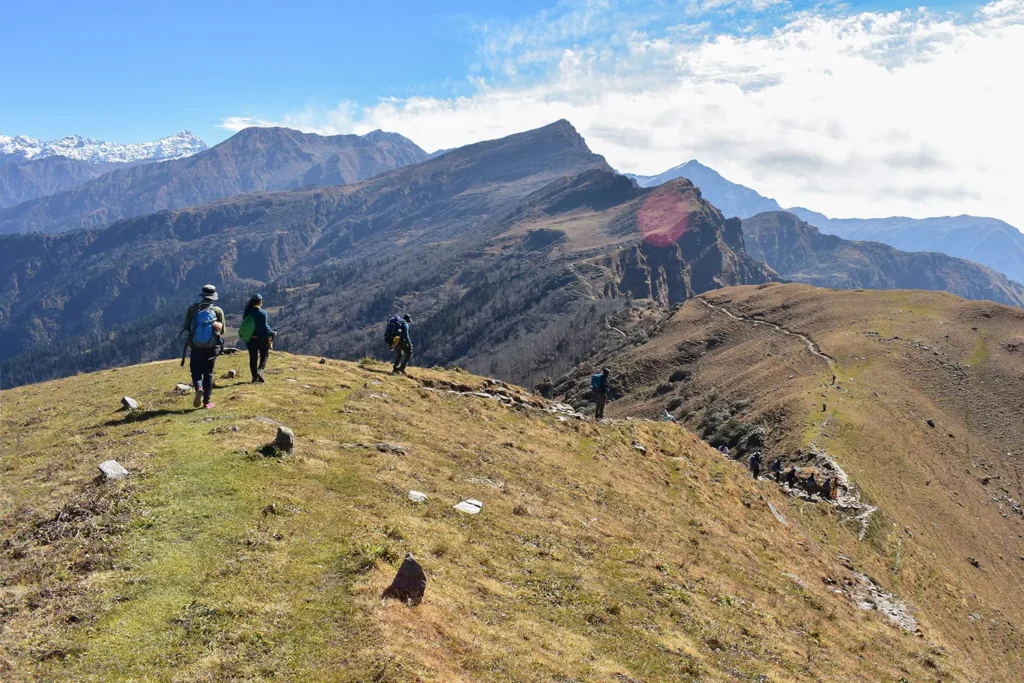
Consider a beginner-level trek to start your trekking journey. These treks are easy and last 3 to 4 days with minimal elevation gain. The easy Himalayan treks take you to an altitude of up to 12,000ft.
Trekking also requires you to invest in proper trekking equipment like trekking shoes, trekking backpacks, and trekking jackets to name a few. While beginning your hiking journey can be an instant decision, trekking in the mountains requires a well-thought-out plan.
Here are a few beginner-friendly treks to begin your trekking journey.
- Triund Trek in Himachal Pradesh
- Tungnath Trek in Uttarakhand
- Deoban Trek in Dehradun
- Rudranath Trek in Uttarakhand
- Deoriatal Trek in Uttarakhand
- Dayara Bugyal Trek in Uttarakhand
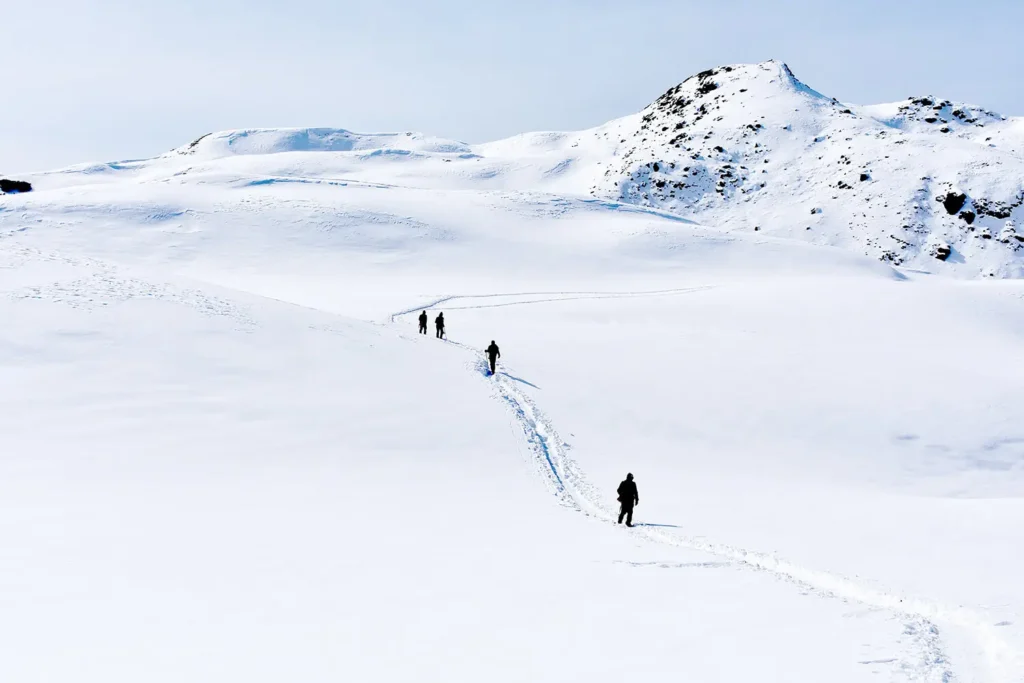
What will you choose? Hiking or Trekking
Hiking and trekking have some similarities but are essentially different activities. Whether going on a hike or a trek, the activity requires a good fitness level and preparation with trekking demanding more effort in preparation. They are as relaxing as they are adventurous. While most people can undertake hiking trekking is more demanding and requires a lot of effort, especially if you are going for a multi-day trek.
Both activities are great choices to begin exploring outdoors. The difference lies in the terrain, difficulty level, altitude, distance covered, and equipment needed. You can choose whichever suits your time and fitness level. However, preparation, knowledge, and safety precautions are key to the successful completion of any activity. So make sure you are well prepared for any adventure you want to take over.

